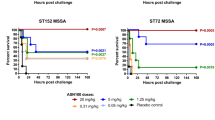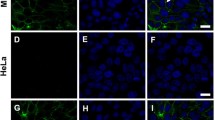Abstract
A group B streptococcus (GBS) isolated from human neonates diagnosed with sepsis and respiratory distress (“early-onset disease”) produces a polysaccharide exotoxin (GBS toxin) that, when infused in sheep, causes lung pathophysiology similar to that seen in humans. Histological studies have demonstrated that GBS toxin induces a strong inflammatory response in the lung, with pulmonary sequestration of granulocytes and extensive capillary endothelial damage. The susceptibility of humans to GBS toxin is age-dependent and limited to about 4 days after birth. It is rarely evident thereafter. This suggests that the binding of GBS toxin to the target endothelium occurs via specific components in the developing lung endothelial cells of the newborn that are later lost. We report here that GBS toxin can also bind to developing endothelium associated with neoplasia and induce an inflammatory response. GBS toxin was shown by immunohistochemistry to bind to capillary endothelium of human large-cell carcinomas. In nude mice bearing human tumor xenografts, intravenously administered GBS toxin caused tumor necrosis and hemorrhagic lesions, and substantially inhibited the rate of growth of the tumors. In BALB/c mice bearing Madison lung tumors, GBS toxin induced an inflammatory response resulting in marked changes in tumor morphology, including vasodilation, endothelial and tumor cell necrosis, invasion of lymphocytes and macrophages, and capillary thrombosis. In these tumor models, no evidence of toxicity to the vasculature of other tissues was observed. The reported pathophysiology of GBS in human neonates, the lack of disease in non-neonates colonized with GBS, and these results suggest that GBS toxin may have potential as a well tolerated agent in cancer therapy of some human tumors.
Similar content being viewed by others
Abbreviations
- GBS:
-
group BStreptococcus
- PBS:
-
phosphate-buffered saline
References
Farber JL, Kyle MK, Coleman JB (1990) Biology of disease-mechanisms of cell injury by activated oxygen species. Lab Invest 62:670–679
Fenton LZ, Strunck RC (1977) Complement activation and group B streptococcal infection in the newborn: similarities to endotoxin shock. Pediatrics 60:901–907
Gomaa K, Kraus J, Roßkopf, Röper H, Franz G (1992) Antitumor and immunological activity of a β1→3/1→6 glucan fromGlomerella cingulata. J Cancer Res Clin Oncol 118:136–140
Hall RT, Barnes W, Krishnan L, Harris DJ, Rhodes PG, Fayez J, Miller GL (1976) Antibiotic treatment of parturient women colonized with group B streptococci. Am J Obstet Gynecol 124:630–634
Hellerqvist CG (1991) US Patent 5,010,062
Hellerqvist CG, Sweetman B (1989) Biomedical applications of massspectrometry. Methods Biochem Analysis 34:91–143
Hellerqvist CG, Rojas J, Green RS, Sell S, Sundell H, Stahlman MT (1981) Studies on group B β-hemolytic streptococcus. I. Isolation and partial characterization of an extra-cellular toxin. Pediatr Res 15:892–898
Hellerqvist CG, Sundell H, Gettins P (1987) Molecular basis for group B β-hemolytic streptococcal disease. Proc Natl Acad Sci USA 84:51–55
Horn KA, Meyer WT, Wyrick BC, Zimmerman RA (1974) Group B streptococcal neonatal infection. J Am Med Assoc 230:1165–167
Kraus J, Franz G (1991) β-(1–3)-Glucans: antitumor activity and immunomodulation. In: Latgé J-P, Boucias D (eds) Fungal cell wall and immune responses. Springer, Berlin Heidelberg New York, pp 431–444
Laird AK (1964) Dynamics of tumor growth. Br J Cancer 18:490–502
Lewko WM, Nayak SK, Hubbard WJ, Thurman GB, Oldham RK (1989) Chemosensitivity in a tumor acquisition, propagation and preservation program. Mol Biother 1:256–260
Nakamura S, Sakurada S, Salahuddin SZ, Osada Y, Tanaka NG, Sakamoto N, Sekiguchi M, Gallo RC (1992) Inhibition of development of Karposi's sarcoma-related lesions by a bacterial cell wall complex. Science 255:1437–1440
Pappas RS, Sweetman B, Ray S, Hellerqvist CG (1990) Monomer sequence determination of carbohydrates using fast-atom bombardment mass-spectrometry of periodate-oxidized acetate ester derivatives. Carbohydr Res 197:1–14
Pyati SP, Pildes RS, Ramamurthy RS, Jacobs N (1981) Decreasing mortality in neonates with early-onset group B streptococcal infection: reality or artifact. J Pediatr 98:625–627
Rettig WJ, Gerin-Chesa P, Healey JH, Su SL, Jaffe EA, Old LJ (1992) Identification of endosialin, a cell surface glycoprotein of vasculature endothelial cells in human cancer. Proc Natl Acad Sci USA 89:10831–10836
Roberts K (1976) Letter. Persistent group B streptococcus bacteremia without clinical sepsis in infants. J Pediatr 88:1059–1060
Rojas J, Green RS, Hellerqvist CG, Olegard R, Brigham KL, Stahlman MT (1981) Studies on group B β-hemolytic streptococcus. II. Effects on pulmonary hemodynamics and vascular permeability in unanesthetized sheep. Pediatr Res 15:899–904
Rojas J, Larson LE, Hellerqvist CG, Brigham KL, Gray ME, Stahlman MT (1983) Pulmonary hemodynamic and ultra-structural changes associated with group B streptococcal toxemia in adult sheep and newborn lambs. Pediatr Res 17:1002–1008
Russell BA, Pappas RS, Brandt JM, Sundell HW, Hellerqvist CG (1988) Immunological and histochemical studies on the pathophysiology of group B streptococcal toxin manifested in early-onset disease. Glycoconj J 6:399
Sandberg K, Engelhart B, Hellerqvist CG, Sundell HW (1987) Pulmonary response to group B streptococcal toxins in young lambs. J Appl Physiol 63:2024–2030
Sundell HW, Fish WG, Sandberg KL, Edberg KE, Pappas RS, Hellerqvist CG (1990) Lung injury by streptococcal toxins. In: Brigham L, Stahlman MT (eds) Respiratory distress syndromes. Vanderbilt University Press, Nashville, Tenn, pp 58–70
Tanaka NG, Sakamoto N, Inoue K, Korenaga H, Kadoya S, Ogawa, H, Osada Y (1989) Antitumor effects of an antiangrogenic polysaccharide from anAnthrobater species with or without a steroid. Cancer Res 49:6727–6730
Thurman GB, Mays CW, Taylor GN, Christense WR, Rehafelf CE, Dougherty TF (1971) Growth dynamics of beagle osteosarcomas. Growth 35:119–125
Author information
Authors and Affiliations
Additional information
This work was supported in part by a grant from the March of Dimes Foundation
Rights and permissions
About this article
Cite this article
Hellerqvist, C.G., Thurman, G.B., Page, D.L. et al. Antitumor effects of GBS toxin: a polysaccharide exotoxin from group Bβ-hemolytic streptococcus. J Cancer Res Clin Oncol 120, 63–70 (1993). https://doi.org/10.1007/BF01200726
Received:
Accepted:
Issue Date:
DOI: https://doi.org/10.1007/BF01200726




